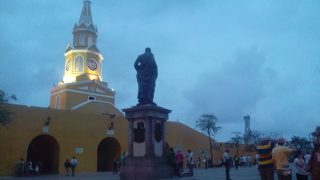 La cittadina di Cartagena ha un centro 'storico' che sembra una bomboniera. Anche conosciuta come la città murata o 'amurallada' per le sue mura di cinta che la circondano, e' situata nella baia del mare dei Caraibi e per la sua posizione e' sempre stata considerata un porto strategico. Le mura della fortificazione e l'inconfondibile stile coloniale delle stradine del quartiere San Pedro le hanno fatto guadagnare il riconoscimento dell'UNESCO dal 1984 come patrimonio culturale mondiale.
La facile critica, che tutti i costeñi sollevano al comune, e' la disparità di trattamento tra la città dentro le mura e la parte fuori dei quartieri popolari, più o meno sicuri. In effetti la differenza e' tanta considerando l'immane flusso di dinero che entra con il turismo e le condizioni fatiscenti di alcuni quartieri, come quello del mercato dove spesso manca acqua ed elettricità. Il centro e' semplicemente impeccabile mentre il resto non viene considerato.
La cittadina di Cartagena ha un centro 'storico' che sembra una bomboniera. Anche conosciuta come la città murata o 'amurallada' per le sue mura di cinta che la circondano, e' situata nella baia del mare dei Caraibi e per la sua posizione e' sempre stata considerata un porto strategico. Le mura della fortificazione e l'inconfondibile stile coloniale delle stradine del quartiere San Pedro le hanno fatto guadagnare il riconoscimento dell'UNESCO dal 1984 come patrimonio culturale mondiale.
La facile critica, che tutti i costeñi sollevano al comune, e' la disparità di trattamento tra la città dentro le mura e la parte fuori dei quartieri popolari, più o meno sicuri. In effetti la differenza e' tanta considerando l'immane flusso di dinero che entra con il turismo e le condizioni fatiscenti di alcuni quartieri, come quello del mercato dove spesso manca acqua ed elettricità. Il centro e' semplicemente impeccabile mentre il resto non viene considerato.
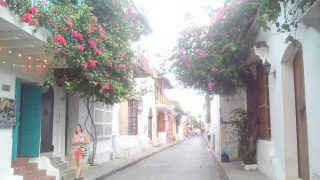 Qui appena scesa dal bus ho conosciuto Amanda, un'americana che vive a Baranquilla – non lontano da Carta, in città per il week end per incontrare il fidanzato colombiano che suona con la sua band; praticamente ho svoltato: ho trovato una persona con cui condividere il taxi, ho trovato le info su ostelli e locali che cercavo, e so anche dove andare la sera!
Trovo un ostello carino nella zona Getzemani della movida cartagenera, tra la piazza Trinidad e Calle Media Luna.
Qui appena scesa dal bus ho conosciuto Amanda, un'americana che vive a Baranquilla – non lontano da Carta, in città per il week end per incontrare il fidanzato colombiano che suona con la sua band; praticamente ho svoltato: ho trovato una persona con cui condividere il taxi, ho trovato le info su ostelli e locali che cercavo, e so anche dove andare la sera!
Trovo un ostello carino nella zona Getzemani della movida cartagenera, tra la piazza Trinidad e Calle Media Luna.
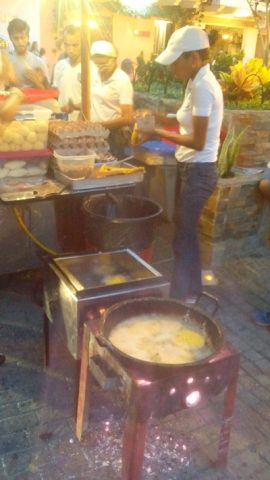 La piazza e' strapiena di gente e mi dicono che nel week end questo e' un punto di ritrovo per turisti e locali. C'e' di tutto artisti di strada, band che suonano e banchi per bere e mangiare. Faccio un giro qui tra la folla e poi mi dirigo ad ascoltare il concerto del fidanzato di Amanda.
I ritmi della costa sono diversi da quelli ascoltati fino ad ora: sono molto piu caldi, ritmati e sensuali; musica tipica di qui e' la chumpeta. La prima volta che l'ho vista ballare non potevo credere fosse legale: e' un ballo di coppia fatto di movimenti porno-sensuali e avvinghiamenti, a mio parere impossibile da ballare con un estraneo.
Ho camminato tante volte per le viuzze del centro di Cartagena, fermandomi a Plaza San Diego per una empanadita fritta o un papa rellena (fatte al momento). Ho anche fatto un tour su una chivas, che e' un pulmino aperto che viene utilizzato per feste ma anche per tour turistici, ovviamente con musica latina sparata a volume altissimo. Un'esperienza kitsch ma divertente, che mi ha fatto vedere la città portandomi fino al monastero di San Agostino (conosciuto come la popa – per la forma della poppa di una barca), los zapatos e il castello/fortezza San Felice.
Anche qui ho incontrato tante belle persone in viaggio come me alla scoperta di questa Colombia magnifica.
Vulcano Totumo
La piazza e' strapiena di gente e mi dicono che nel week end questo e' un punto di ritrovo per turisti e locali. C'e' di tutto artisti di strada, band che suonano e banchi per bere e mangiare. Faccio un giro qui tra la folla e poi mi dirigo ad ascoltare il concerto del fidanzato di Amanda.
I ritmi della costa sono diversi da quelli ascoltati fino ad ora: sono molto piu caldi, ritmati e sensuali; musica tipica di qui e' la chumpeta. La prima volta che l'ho vista ballare non potevo credere fosse legale: e' un ballo di coppia fatto di movimenti porno-sensuali e avvinghiamenti, a mio parere impossibile da ballare con un estraneo.
Ho camminato tante volte per le viuzze del centro di Cartagena, fermandomi a Plaza San Diego per una empanadita fritta o un papa rellena (fatte al momento). Ho anche fatto un tour su una chivas, che e' un pulmino aperto che viene utilizzato per feste ma anche per tour turistici, ovviamente con musica latina sparata a volume altissimo. Un'esperienza kitsch ma divertente, che mi ha fatto vedere la città portandomi fino al monastero di San Agostino (conosciuto come la popa – per la forma della poppa di una barca), los zapatos e il castello/fortezza San Felice.
Anche qui ho incontrato tante belle persone in viaggio come me alla scoperta di questa Colombia magnifica.
Vulcano Totumo
 Vicino Carta, c'e' il vulcano Totumo che non e' un vero vulcano, ma una sporgenza a forma di vulcano profonda 2300 metri piena di fango argilloso che permette alle persone di galleggiare. Dicono che faccia bene alla pelle e che ringiovanisca, sinceramente non saprei io ho provato un piacere primordiale nell'immergermi in quella poltiglia fangosa. Il piacere e' lo stesso di un bambino che salta nelle pozzanghere, gioca con il fango o la sabbia, la profonda goduria nello sporcarsi.
Dopo i fanghi si scende nella laguna di acqua dolce per lavarsi o per farsi lavare, servizio offerto a pagamento dalle donne locali.
Arcipelago del Rosario: Isla Grande e Isla Baru'
Per andare a Isla Grande si parte dal muelle (porto) di Carta, dove si negozia tutto anche il passaggio in barca alle isole. Cosi ho fatto, giocando a ribasso con le varie compagnie.
Vicino Carta, c'e' il vulcano Totumo che non e' un vero vulcano, ma una sporgenza a forma di vulcano profonda 2300 metri piena di fango argilloso che permette alle persone di galleggiare. Dicono che faccia bene alla pelle e che ringiovanisca, sinceramente non saprei io ho provato un piacere primordiale nell'immergermi in quella poltiglia fangosa. Il piacere e' lo stesso di un bambino che salta nelle pozzanghere, gioca con il fango o la sabbia, la profonda goduria nello sporcarsi.
Dopo i fanghi si scende nella laguna di acqua dolce per lavarsi o per farsi lavare, servizio offerto a pagamento dalle donne locali.
Arcipelago del Rosario: Isla Grande e Isla Baru'
Per andare a Isla Grande si parte dal muelle (porto) di Carta, dove si negozia tutto anche il passaggio in barca alle isole. Cosi ho fatto, giocando a ribasso con le varie compagnie.
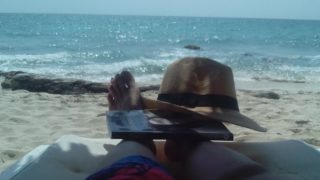 Arrivo anzi mi scaricano sull'isola circondata da acqua cristallina e palme, mettendomi subito alla ricerca dell'eco-ostello prenotato. Ho smobilitato tutti i 450 membri della comunita' dell'isola nella peripezia della ricerca: la prenotazione era a nome di un ostello della citta' che possiede uno stabile sull'isola, ma io non lo sapevo. Alla fine un omone mi scorta fino al cancello, dove trovo una struttura con casette colorate che appartengono a diversi ostelli di Carta; l'idea della 'comune alberghiera' e' buona ma hanno appena iniziato e hanno una marea di lavoro da fare.
Quando arrivo ci sono tante coppie che fortunatamente vanno via dopo pranzo. Cosi rimango sola con Aguardiente e Fernet, i due impiegati dell'ostello, un colombiano e un argentino che mi han fatto scortata durante il soggiorno, accompagnata in 'centro' per comprare pane fatto in casa e arepas e offerto agua ardiente e fernet con coca cola (ovvio!). In pratica ho avuto spiaggia, piscina, ostello tutti per me.
Arrivo anzi mi scaricano sull'isola circondata da acqua cristallina e palme, mettendomi subito alla ricerca dell'eco-ostello prenotato. Ho smobilitato tutti i 450 membri della comunita' dell'isola nella peripezia della ricerca: la prenotazione era a nome di un ostello della citta' che possiede uno stabile sull'isola, ma io non lo sapevo. Alla fine un omone mi scorta fino al cancello, dove trovo una struttura con casette colorate che appartengono a diversi ostelli di Carta; l'idea della 'comune alberghiera' e' buona ma hanno appena iniziato e hanno una marea di lavoro da fare.
Quando arrivo ci sono tante coppie che fortunatamente vanno via dopo pranzo. Cosi rimango sola con Aguardiente e Fernet, i due impiegati dell'ostello, un colombiano e un argentino che mi han fatto scortata durante il soggiorno, accompagnata in 'centro' per comprare pane fatto in casa e arepas e offerto agua ardiente e fernet con coca cola (ovvio!). In pratica ho avuto spiaggia, piscina, ostello tutti per me.
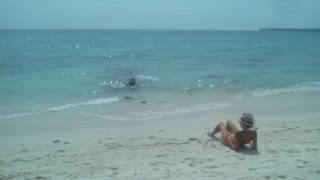 Tappa successiva e' playa blanca sull'isla Baru', dove arrivo con un passaggio concesso dal capitano malandrino su di una barchetta turistica piena di gringos unti di crema per il sole. La spiaggia inondata da turisti e' un delirio, che pero' prende anima e vita dopo la partenza pomeridiana dei turisti che tornano a Carta. Sono stata felicissima di aver deciso di stare due notti godendomi i tramonti e l'alba su questa spiaggia bianca perennemente in costume, dormendo sull'amaca tra cocco e banano chips, in una compagnia di musicisi argentini.
Solo due note stonate: la prima, i locali simpaticissimi ma avvelenati con le turiste; la seconda, il lavoro infimo del comune per espropiare i chioschi dei nativi per vendere o appaltare la spiaggia ad una compagnia che vuole costruire una albergo-mostro. Putroppo e' vero che i soldi dettano legge in tutto il mondo. Che peccato.
Intanto io ho conosciuto Ugo che lavora nell'ostello dove ho dormito, il quale rassegnato capisce che meglio essere amici e mi presenta ai suoi amici facilitando a costo zero il mio ultimo soggiorno a Carta.
Prossima e ultima tappa la capitale, Bogota'.
Tappa successiva e' playa blanca sull'isla Baru', dove arrivo con un passaggio concesso dal capitano malandrino su di una barchetta turistica piena di gringos unti di crema per il sole. La spiaggia inondata da turisti e' un delirio, che pero' prende anima e vita dopo la partenza pomeridiana dei turisti che tornano a Carta. Sono stata felicissima di aver deciso di stare due notti godendomi i tramonti e l'alba su questa spiaggia bianca perennemente in costume, dormendo sull'amaca tra cocco e banano chips, in una compagnia di musicisi argentini.
Solo due note stonate: la prima, i locali simpaticissimi ma avvelenati con le turiste; la seconda, il lavoro infimo del comune per espropiare i chioschi dei nativi per vendere o appaltare la spiaggia ad una compagnia che vuole costruire una albergo-mostro. Putroppo e' vero che i soldi dettano legge in tutto il mondo. Che peccato.
Intanto io ho conosciuto Ugo che lavora nell'ostello dove ho dormito, il quale rassegnato capisce che meglio essere amici e mi presenta ai suoi amici facilitando a costo zero il mio ultimo soggiorno a Carta.
Prossima e ultima tappa la capitale, Bogota'.
Cartagena and the Rosario Islands
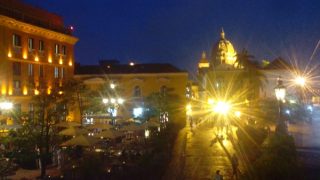 The town center of Cartagena looks like a bomboniere. Also known as the walled city or 'amurallada' for its walls that surround it; for its location in the bay of the Caribbean Sea has been always considered a strategic port. The walls of the fort and the unmistakable style of the colonial streets of San Pedro district has earned recognition as UNESCO world cultural heritage since 1984.
The easy criticism that all costeñi raise to the municipality is the difference in treatment between the CBD within the walls and the outside part of the neighbourhoods, more or less safe. In fact the difference is a lot, considering the huge flow of money that enters with the tourism and the dilapidated condition of some neighbourhoods, such as the market area which is often lacking of water and electricity. The center is simply flawless while the rest is ignored.
The town center of Cartagena looks like a bomboniere. Also known as the walled city or 'amurallada' for its walls that surround it; for its location in the bay of the Caribbean Sea has been always considered a strategic port. The walls of the fort and the unmistakable style of the colonial streets of San Pedro district has earned recognition as UNESCO world cultural heritage since 1984.
The easy criticism that all costeñi raise to the municipality is the difference in treatment between the CBD within the walls and the outside part of the neighbourhoods, more or less safe. In fact the difference is a lot, considering the huge flow of money that enters with the tourism and the dilapidated condition of some neighbourhoods, such as the market area which is often lacking of water and electricity. The center is simply flawless while the rest is ignored.
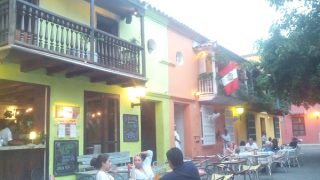 Here just I got off the bus I met Amanda, an American girl who lives in Barranquilla - not far from the Carta; she is in town for the weekend to meet her Colombian boyfriend who plays with his band on the night. I practically got bingo: I found someone to share the taxi with, the information about hostels and rooms I was looking for, and I knew where to go in the evening!
I found a nice hostel in Gethsemane, the Cartagenera nightlife area, between the square Trinidad and Calle Media Luna. The square was packed with people and they told me that over the weekend this is the meeting point for tourists and locals. There are street artists, bands playing and stalls for eating and drinking. I did a tour in the crowd, and then I headed to listen to the concert of Amanda's boyfriend.
Here just I got off the bus I met Amanda, an American girl who lives in Barranquilla - not far from the Carta; she is in town for the weekend to meet her Colombian boyfriend who plays with his band on the night. I practically got bingo: I found someone to share the taxi with, the information about hostels and rooms I was looking for, and I knew where to go in the evening!
I found a nice hostel in Gethsemane, the Cartagenera nightlife area, between the square Trinidad and Calle Media Luna. The square was packed with people and they told me that over the weekend this is the meeting point for tourists and locals. There are street artists, bands playing and stalls for eating and drinking. I did a tour in the crowd, and then I headed to listen to the concert of Amanda's boyfriend.
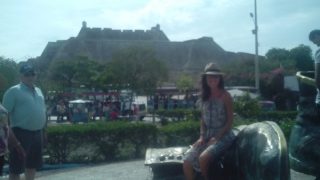 The rhythms of the coast are different from those heard until now: they are much more warm, rhythmic and sensual; typical music of here is the the chumpeta. The first time I saw this dance I could not believe it was legal: it is a couple dance where the two are glued together moving porn-sensual steps! In my opinion impossible to dance with a stranger.
I walked many times through the narrow streets of the center of Cartagena, stopping in Plaza San Diego for a fried empanadita or a papa rellena (made on the spot). I also did a tour in a chivas, which is an open minibus that is used for parties but also for sightseeing tours, obviously with Latin music at high volume. It was kitschy but fun experience, which allowed me to see the city, taking me to the monastery of St. Augustine (known as the stern - the shape of the stern of a boat), los zapatos and the castle/fortress of San Felice.
Once more, I met many nice people traveling like me to discover this magnificent Colombia.
Volcano Totumo
The rhythms of the coast are different from those heard until now: they are much more warm, rhythmic and sensual; typical music of here is the the chumpeta. The first time I saw this dance I could not believe it was legal: it is a couple dance where the two are glued together moving porn-sensual steps! In my opinion impossible to dance with a stranger.
I walked many times through the narrow streets of the center of Cartagena, stopping in Plaza San Diego for a fried empanadita or a papa rellena (made on the spot). I also did a tour in a chivas, which is an open minibus that is used for parties but also for sightseeing tours, obviously with Latin music at high volume. It was kitschy but fun experience, which allowed me to see the city, taking me to the monastery of St. Augustine (known as the stern - the shape of the stern of a boat), los zapatos and the castle/fortress of San Felice.
Once more, I met many nice people traveling like me to discover this magnificent Colombia.
Volcano Totumo 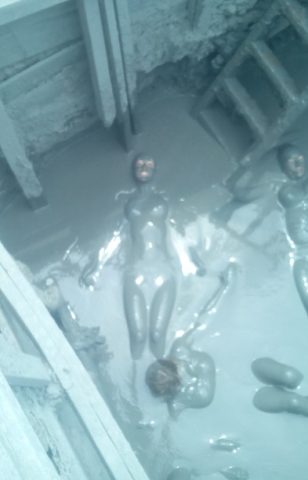 Near Carta, there is vulcan Totumo which is not a real volcano, but a hump shaped like a volcano of 2300 meters deep with muddy clay that allows people to float. They say it is good for the skin as rejuvenates it, I really do not know but I felt a wild pleasure in fully immersing myself in that muddy mush.
The pleasure is the same felt by a child jumping in puddles, playing with mud or sand, the deep pleasure of getting dirty.
After the sludge, I went into the lagoon of fresh water to wash or to be washed by a local women for a small charge (this is how the local economics works here).
Archipelago of the Rosario: Isla Grande and Isla Baru'
To go to Isla Grande I needed to come down the muelle (harbor) of Cartagena, where I negotiated the passage with a boat. So I played with the various companies trying to get the best price.
Near Carta, there is vulcan Totumo which is not a real volcano, but a hump shaped like a volcano of 2300 meters deep with muddy clay that allows people to float. They say it is good for the skin as rejuvenates it, I really do not know but I felt a wild pleasure in fully immersing myself in that muddy mush.
The pleasure is the same felt by a child jumping in puddles, playing with mud or sand, the deep pleasure of getting dirty.
After the sludge, I went into the lagoon of fresh water to wash or to be washed by a local women for a small charge (this is how the local economics works here).
Archipelago of the Rosario: Isla Grande and Isla Baru'
To go to Isla Grande I needed to come down the muelle (harbor) of Cartagena, where I negotiated the passage with a boat. So I played with the various companies trying to get the best price.
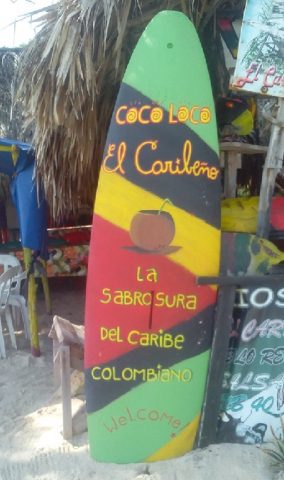 Once I arrived or once they thrown me out of the boat in the island, which was surrounded by crystal clear water and palm trees, I put myself immediately in searching the eco-hostel. I have mobilized all 450 members of the island community for this search/adventure: the reservation was on the hostel name in the city, which had a twin accommodation in the island, but I did not know at that time.
Finally, a big man escorted me to a gate, where I found a structure with colourful houses that belonged to different Cartagena's hostels. The idea of a 'community hotel' was good but they had just started and had a lot of work to do.
When I arrived, there were many couples (too many), which happily left after lunch.
So there I was! I basically had the beach, the pool, the hostel all for me.
I remained alone with Aguardiente and Fernet, the two hostel employees, one Colombian and one Argentinian, who took me around, to the 'center' to buy homemade bread and arepas for dinner and offered Agua ardiente and Fernet with coke (of course!).
The following stop was Playa Blanca on Isla Baru', to where I arrived with a lift from a really cheeky captain of a touristic boat full of greasy gringos marked as aboriginals with sun screen lotion.
Once I arrived or once they thrown me out of the boat in the island, which was surrounded by crystal clear water and palm trees, I put myself immediately in searching the eco-hostel. I have mobilized all 450 members of the island community for this search/adventure: the reservation was on the hostel name in the city, which had a twin accommodation in the island, but I did not know at that time.
Finally, a big man escorted me to a gate, where I found a structure with colourful houses that belonged to different Cartagena's hostels. The idea of a 'community hotel' was good but they had just started and had a lot of work to do.
When I arrived, there were many couples (too many), which happily left after lunch.
So there I was! I basically had the beach, the pool, the hostel all for me.
I remained alone with Aguardiente and Fernet, the two hostel employees, one Colombian and one Argentinian, who took me around, to the 'center' to buy homemade bread and arepas for dinner and offered Agua ardiente and Fernet with coke (of course!).
The following stop was Playa Blanca on Isla Baru', to where I arrived with a lift from a really cheeky captain of a touristic boat full of greasy gringos marked as aboriginals with sun screen lotion.
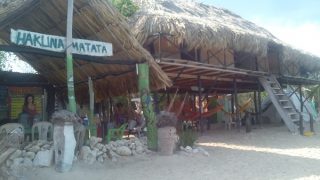 The beach flooded with tourists was frenzy, but it revealed its real soul and face after the afternoon departure of the tourists who returned to Carta. I was very happy to have decided to stay two nights enjoying the sunsets and sunrise on this white beach wearing my bikini, sleeping in hammock between coconut and banana chips, and the company of Argentinean musicians.
Only a couple of bad notes: the first one, the local men were very nice but pushy with tourists; the second one, council is working to expropriate the kiosks from the natives to sell or outsource the beach to a company that wants to build a monster-hotel. Unfortunately, it's true that money calls the shots in the world. What a pity.
Meanwhile I met Hugo, who worked in the hostel where I stayed; once finally he gave up and understood that was better to be friends, he introduced me to his friends facilitating my trip back to Carta and my last days in the city.
Next and last stop The Capital, Bogota’.
The beach flooded with tourists was frenzy, but it revealed its real soul and face after the afternoon departure of the tourists who returned to Carta. I was very happy to have decided to stay two nights enjoying the sunsets and sunrise on this white beach wearing my bikini, sleeping in hammock between coconut and banana chips, and the company of Argentinean musicians.
Only a couple of bad notes: the first one, the local men were very nice but pushy with tourists; the second one, council is working to expropriate the kiosks from the natives to sell or outsource the beach to a company that wants to build a monster-hotel. Unfortunately, it's true that money calls the shots in the world. What a pity.
Meanwhile I met Hugo, who worked in the hostel where I stayed; once finally he gave up and understood that was better to be friends, he introduced me to his friends facilitating my trip back to Carta and my last days in the city.
Next and last stop The Capital, Bogota’. 